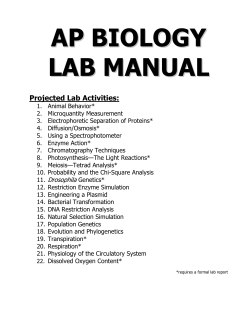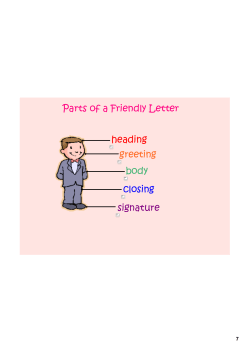
How to Write a Chemistry Lab Report
How to Write a Chemistry Lab Report A lab report is one of a scientist’s most valuable tools. It is a permanent record of everything that takes place in the laboratory. A properly written lab report contains unambiguous statements of what was done and observed by the scientist. It is a factual account of a researcher’s work. Our lab reports will be written in a bound notebook with numbered pages. Only the pre-lab (final draft), the data, the calculations, and the conclusion should be included in the lab book; rough drafts should not be included in the bound notebook. Since the report is to be a permanent record, it is to be written IN INK (blue or black only) so it cannot be easily altered. Labs may not be re-written or typed, so BE NEAT the first time! A chemistry lab report is an INDIVIDUAL report. You are to write it on your own, IN YOUR OWN WORDS. For every section that is the same as your lab partner’s (or anyone else’s), you will both receive NO CREDIT (a score of zero). NO COPYING!! DO NOT ERASE OR COVER MISTAKES!!! Just draw a thin line through the mistake, make the change, and initial it. Do not erase mistakes, use “white out,” or scribble over mistakes. “Mistakes” may be correct or may be of help later! You will not be marked down for correctly corrected mistakes! ( Miss Gergunis mistake Miss Gergunis not correct Miss GergunisKG correct Cover of Lab Book On the cover of your lab book, your name, course (Chemistry), and hour should be clearly marked. If you would like to decorate the outside of your lab book, that is fine as long as the above information is still clearly visible. Jane Scientist Chemistry nth hour Numbered Pages The pages in your lab book should be numbered IN BLUE OR BLACK INK to show that you did not add or remove pages during the course of a lab. This emphasizes that your work is your own and is what you actually did/observed during lab. Odd numbers are on the right-hand pages; left-hand pages should have even numbers. Every page in your lab book should be numbered. RIGHT LEFT 1 2 RIGHT 3 Table of Contents As the year progresses, we will do a lot of labs. It is nice to be able to quickly look at a table of contents to find where in your lab book you need to look. Your table of contents should be on page 1 of your lab book and should list the lab titles and the pages they begin on. Example: Table of Contents Lab Title Starts on Page Glass Manipulation and Massing Lab 3 Accuracy and Precision Lab 10 Thermal Decomposition Lab 18 The sections of a chemistry lab report are: Title Heading Goal Research “PRE-LAB” (completed BEFORE LAB) Materials Hazards Procedure Data -- written DURING LAB Calculations (not always needed–skip it if not needed) -- written AFTER LAB Conclusion -- written AFTER LAB A Each section starting with the goal should include a heading (such as Hazards), and the information under that heading should be BLOCK INDENTED (every line in that section indented, not just the first one). Goal: The goal of this lab is to determine the boiling point of water in degrees Celsius. Research: A boiling point is the temperature at which a pure substance changes from the liquid state to the gas state when heated. There are three common temperature scales: Celsius, Fahrenheit, and Kelvin. Fahrenheit is commonly used in the United States, but most of the rest of the world records temperatures in Celsius . . . Materials: 1 Celsius thermometer 1 25 x 150 mm test tube 1 Bunsen burner 1 sparker 1 heat resistant pad 1 ringstand Title and Heading Each lab will have a title. You may come up with your own title or use the one provided. A lab’s title related to its goal, equipment, or data. To the right of the title, the lab’s heading should contain your name, the date(s) of the lab, your class hour, and the name(s) of your partner(s). Example of a title and heading: Glass Manipulation Lab Jane Scientist September 16, 2011 nth Hour John Labworker Goal Each lab handout will list the goal of the lab. Copy it word-for-word into your lab book. Make sure your focus is always on meeting the lab’s goal! Research Before starting a lab, it is important to understand some of the ideas and chemistry behind what will happen. Each lab handout will include a list of research questions to be answered before lab begins. These questions are designed to help you understand what is going on in the lab. Please note that your research section should be written in sentences and paragraphs (NOT A NUMBERED LIST!!!). Don’t write the questions! Equations should be written on their own lines and centered. Diagrams and calculations may also be included when necessary. Do your best to put definitions and research IN YOUR OWN WORDS! If there is something you can’t figure out how to put in your own words, put quotations around it to show it was copied (quoted) from somewhere else. List sources (where you find your information [title of book and page number, full website address, or person you spoke to]) at the end of each answer in parentheses. The more details and information included in the research, the better your grade will be! NOTE #1: Current and former LHS students are not acceptable sources. NOTE #2: No research = no lab! Materials The materials section of the lab report will list the materials, chemicals, and equipment you plan to use to complete the lab. It is written in TWO columns (NOT ONE, NOT THREE) that should NOT cross each other and should be approximately the same length. Materials are listed in the following format: number required description/size/amount name of item/chemical Example: Materials: 1 Bunsen burner 3 50 mL graduated cylinders 25 mL 6 M HCl 1 heat resistant pad 6.59 g K2Cr2O7 2 #6 2-hole rubber stoppers 4 25 x 150 mm test tubes There are a few things that are NEVER included in a materials list: liquid water of any kind, paper towels, goggles, aprons, lab books, pens, lab desks, and lab partners. Hazards Always begin your hazards section with the sentence “The student safety contract applies.” Then use complete sentences to mention the hazards of each chemical being used during the lab. Be sure to mention any special precautions or safety equipment needed (such as gloves or the explosion barrier). The safety contract is mentioned so you do not have to repeat the thirty safety rules every lab. Copies of MSDS sheets are available at http://www.flinnsci.com/search_MSDS.asp Procedure Your procedure is your step-by-step list of how you plan to complete the lab. It should include cleaning equipment, setting up equipment, taking measurements, performing reactions, and even cleaning up. It should NOT include doing calculations or writing the conclusion. Each step should begin with a verb. All procedures should include any diagrams you will need (especially of your set-up). You CANNOT have your lab handout or rough draft at your desk during lab (as they pose a fire hazard). Make sure to clearly label all set-up diagrams. Here is an example procedure: Procedure: 1. Physically clean glassware using test tube brush and tap water 2. Chemically clean glassware using distilled water 3. Dry equipment 4. Label beaker HCl 5. Take beaker to hood 6. Put on gloves 7. Pour HCl into beaker 8. Measure 50 mL HCl using graduated cylinder The final step of any procedure should be “Clean up.” Never use I, we, you, me, or other pronouns in a procedure! Focus on what should be done, not who is doing it! If a step is about setting up equipment or building something, a detailed, labeled diagram of what is being set up or built should be included next to that step in the procedure. DO NOT write “get materials” or “record data.” Be more specific! Better examples would be “get 40 mL of HCl in 100 mL beaker” or “record height of flame.” Data Data is the most crucial part of a lab report. It requires you to record something about everything you do in lab. More data = better data! Record colors, smells, shapes, and measurements! Be sure to use words, numbers, and sketches during every lab. Charts are also helpful; they may be set-up in your lab book before lab starts. At the end of each day of lab, sign and date your data, have your partner(s) sign your data, and have the teacher initial that you have cleaned up your lab station. Any unused space on the page should be crossed out to show you will not add data after lab. Calculations (Skip this section for labs with no calculations) The hardest thing to do in a calculations section is to make sure the reader can follow your math. Be sure to show which formulas you are using and where your numbers come from. Example: Calculations: q = c · m A ÄT q=? m = 25.06 g (mass of my metal) ÄT = final temp - initial temp = 26.0 °C - 100.0 °C = -74.0 °C c = q / (m A ÄT) = Conclusion Your conclusion tells the reader what you learned from the lab. It starts by giving your answer to the goal. Next, it explains how you figured out your answer by discussing your logic/reasoning, important data, and calculations (all to support your answer). It then explains any problems that occurred during your lab (if there were any). Finally, it lists at least one SPECIFIC way the lab could be improved (but “more time” will not get you any credit). The four sentence starters for the conclusion are: (1) My answer is . . . (give your answer to the goal) (2) I know this because . . . (explain your reasoning/method/ how you got your answer AND mention the SPECIFIC DATA AND CALCULATIONS [usually at least two things] that helped you determine the answer) (3) A problem was . . ./Some problems were . . . (list at least one thing that went wrong during lab) (4) If I did this lab again, I . . . (list a specific way the lab could go better if you had to do it again, or suggest an improvement for next year when the lab is done) Lab Grades 1st 2nd You must have a complete pre-lab (title, heading, goal, research, materials, hazards, and procedure) when you walk in for lab. Only pre-labs in the lab book in blue or black ink will be considered for grading. If your pre-lab is incomplete (missing a section, poorly done [incomplete or unsafe materials, procedure, and/or hazards], not in your lab book, or not in blue or black ink), you will not be allowed to do the lab. If your pre-lab is incomplete, you may complete your pre-lab during class in the classroom while wearing goggles and sit out the lab. Those who have completed pre-labs are allowed to do the lab. Those who do not will not ever do the lab. There are no make-up labs if a person is unprepared (has not completed his/her pre-lab, does not have his/her lab book, has written his/her prelab in pencil/red ink/green ink, does not have the proper attire/shoes, has not passed the safety quiz, has not brought in a signed safety contract, etc.)!!! Please note that if you arrive more than 10 minutes late for a lab, you may not do the lab. 3rd Those who do the lab and turn in a completed lab report may received up to 20 points. See the sample rubric below for the details: **NOTE: Not every section will be checked for every lab.**
© Copyright 2025





















